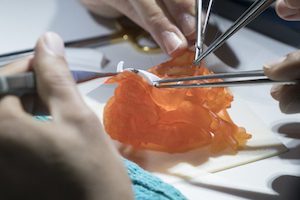3D printing technology pioneer Stratasys introduced BioMimics, which provides highly realistic, functionally accurate 3D-printed replicas of complex anatomical structures.
Available as a service through Stratasys Direct Manufacturing in North America, BioMimics empowers more effective medical training, education and advanced device testing, according to Stratasys.
The technology eliminates restrictions associated with training, research and testing on animal, mannequin or cadaver models by effectively replicating the intricacies of both soft tissue and hard bones via multi-material 3D printing.
Combining Stratasys’ proven PolyJet 3D printing alongside new materials and software, organizations can create specific 3D-printed models that match what professionals encounter during live medical scenarios.
Additionally, OEMs can gain real-time feedback on device performance in realistic environments prior to actual deployment, said Stratasys.
In a video posted by Stratasys on YouTube and embedded below, Dr. Glen van Arsdell, Head of Cardiovascular Surgery at the Hospital for Sick Children in Toronto, describes the impact that 3D-printed medical models are having on his professsion.
“My primary job is to safely take care of children who have major problems with their heart,” said van Arsdell. “One of my secondary jobs is teaching the next generation to help children who have problems with their heart.
3D models are all about trying to do that safely—learning on models instead of learning on patients.”
Another surgeon in the video discusses the benefits of 3D printed models when testing new devices and procedures—specifically, how a particular type of tubing will navigate through the body to the brain.
“We designed a series of models with varying levels of tortuosity from the chest to the brain,” said Dr. Adnan Siddiqui, Associate Professor of Neurosurgery and Radiology at State University of New York at Buffalo and Director of Neurosurgical Stroke Service at Kaleida Health.
“It’s impossible to do in animals or in patients. 3D printing makes it so easy to do that in a smooth, streamlined fashion.”
For testing purposes, animal models only approximate human anatomy and cadavers don’t retain the feel of live tissue and often lack targeted pathology, said Scott Rader, GM of Healthcare Solutions at Stratasys.
“BioMimics is a revolution in medical modeling, capitalizing on advanced 3D-printing techniques for clinically accurate representations of complex human anatomies, from microscopic patterns of tissue to replicating soft to hard texture of body structures.
Armed with the unmatched realism of BioMimics, researchers, educators and manufacturers can finally utilize the tools to prove out new ideas long before clinical trials, and demonstrate innovations to the skilled physicians who rely on them,” said Rader.
Initially designed to model the complexities of heart and bone structures, the BioMimics portfolio will expand to include vascular anatomies in early 2018.
BioMimics is being demonstrated for the first time at the 103rd Scientific Assembly and Annual Meeting of the Radiological Society of North America this week in Chicago.
Stratasys Direct Manufacturing will exhibit at Medical Design & Manufacturing (MD&M) West, co-located with PLASTEC West, in Anaheim, CA, on Feb. 6 to 8, 2018. Visit the company at booth 3515.



